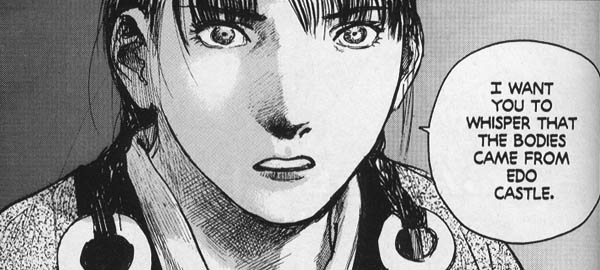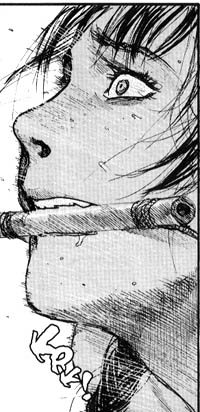 By Hiroaki Samura
By Hiroaki Samura
168 pages, black and white
Published by Dark Horse
About ten years ago, I picked up the first collected volume of Blade of the Immortal; Dark Horse started publishing Hiroaki Samura’s fantastical samurai story in the late ’90s, and I’d heard enough good things about the series to give it a try. I was hooked, and for years I read each new volume as it showed up. Then, about four years ago, I got the idea that I’d re-read the entire series when the next volume was released. I kept buying the new volumes even as I put them aside, unread, while telling myself that sooner or later I’d tackle such a feat. Suddenly I realized that I’d stockpiled no less than eight volumes of Blade of the Immortal (how did four years pass by so quickly?), and if there was ever a time to finally catch up, this was it. And oh, how things had changed since I’d last read the book.
Manji is a warrior who has been either blessed or cursed (depending on whom you ask) with the gift of immortality; strange creatures called bloodworms knit his body back together every time he is injured, and will continue to do so until he has killed 1000 evil men to atone for his past actions of killing 100 good men. He was on a path of redemption by serving as a bodyguard for Rin, a young woman whose family was slain by a group named the Itto-ryu, and against whom Rin has sworn revenge. But now their quest has been horribly derailed as Manji is captive under Edo Castle as a madman tries to replicate Manji’s immortality. Can Rin and her uneasy ally Doa infiltrate Edo Castle through the hidden "badger hole" underneath the castle, or will this be too much for this pair of warrior women?

I have to give credit to Samura, Blood of the Immortal never sits on its laurels for too long. Every time the book seems to be getting too comfortable in its status quo, he shakes things up, often separating its main characters of Rin and Manji. This new volume, Badger Hole, certainly continues Rin’s evolution as a character throughout the entire series. When Blood of the Immortal opened she was a headstrong, rash girl who clearly was not prepared for the world after being sheltered for years in her father’s dojo. By now, she’s a much more confident, cunning woman. Her plan to infiltrate Edo Castle is more than just charging ahead, instead thinking through just what she and Doa will need to succeed. Likewise, Manji is certainly a much calmer, more patient character than he was in the early volumes as he bides his time and keeps his cool throughout what is definitely one of the most horrific sequences of the entire series.
 Blade of the Immortal is certainly not for the squeamish or weak of heart; violence is continually present here, often finding the characters even as they try and avoid it. At the same time, though, I think it’s gotten to the point where it’s never really gratuitous. When fights happen in these later volumes of Blade of the Immortal, it’s something that is advancing the plot. From Doa’s rash decision that separates her from Isaku, to Rin trying to spare Doa and their assistant from a captor’s wrath, everything happens for a reason. Fighting is more often than not the order of Blade of the Immortal, but I appreciate that Samura’s writing now makes sure that it’s always appropriate.
Blade of the Immortal is certainly not for the squeamish or weak of heart; violence is continually present here, often finding the characters even as they try and avoid it. At the same time, though, I think it’s gotten to the point where it’s never really gratuitous. When fights happen in these later volumes of Blade of the Immortal, it’s something that is advancing the plot. From Doa’s rash decision that separates her from Isaku, to Rin trying to spare Doa and their assistant from a captor’s wrath, everything happens for a reason. Fighting is more often than not the order of Blade of the Immortal, but I appreciate that Samura’s writing now makes sure that it’s always appropriate.
I really do love Samura’s art. I think it’s at its finest in the quieter moments of the book; I look at a facial portrait of Rin talking to someone and I’m amazed at the delicate lines that Samura uses to define every single piece of hair, each individual eyelash. Maybe it’s because those moments of quiet are so treasured by the main characters that they stand out so much; fortunately Samura’s also good at the more active portions of the book. You can see the terror and hurt in Rin’s eyes as she bites down on a piece of bamboo while being flogged, or the whirlwind of action as the swords come out in a fight to the death. For all of the softness that Samura can infuse into his work, it’s those fight scenes that lets him show off a more jagged, visceral side to his art that is hard to ignore. It’s also worth noting that instead of reading right-to-left, Samura’s pages of art were instead cut apart panel-by-panel and then reassembled to read left-to-right. It produces some strange moments where characters that should be looking at other panels are instead staring off the edge of the page, but it stands out as an inventive way to create a left-to-right edition of a comic from Japan without mirror-imaging each page.
I have to say, I enjoyed my re-read of Blade of the Immortal (followed by reading volumes 12 through 19 for the first time) so much I’m half-tempted to do the same thing with another series, soon. To be fair, though, I’m not sure how many other books would hold up quite as well. Part of the joy of this massive reading marathon was watching Samura slowly change his characters as well as his own writing and art style; with the series nearing its conclusion in Japan, it was definitely the perfect time to give this series another shot.
Purchase Links:
